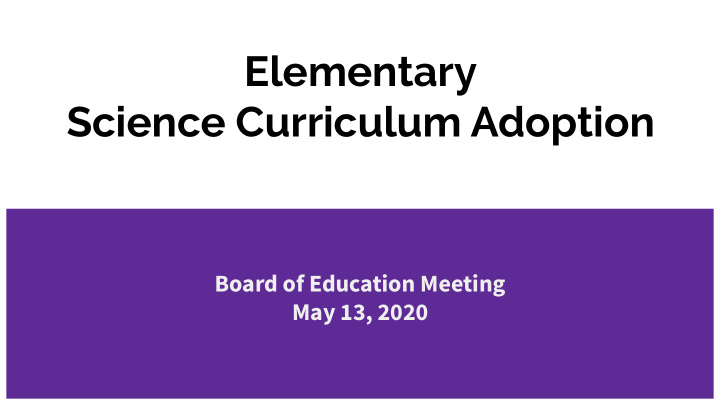



Elementary Science Curriculum Adoption Board of Education Meeting May 13, 2020
California Dept of Education Timeline ● Adopted California NGSS-Aligned Standards - 2013 ● Adopted California Science Framework - 2016 ● Administered California Science Test (CAST) - 2017 ● Adopted State-approved curriculum - 2018 ● ACOE led training on State-approved instructional materials tools (TIME) - 2019
Timeline March/April Science Curriculum Adoption process, plan, and timeline were 2019 shared with teachers and classified staff March/April Prescreening of all state-adopted materials 2019 Evaluated 11 programs using the State Adoption Toolkit June Paper screening of two programs 2019 Selected Amplify Science to pilot in Fall 2019 May - Nov Pilot Committee members selected, were trained, and taught 2019 Amplify Science pilot units December Adoption Committee determined that we should NOT move 2019 forward with adopting Amplify Science
Timeline January Adoption Committee completed paper screening of two additional 2020 programs January Adoption Committee recommended Piloting Smithsonian: Science 2020 in the Classroom Jan - March Pilot Committee trained on Smithsonian: Science in the 2020 Classroom, taught, and collected data on pilot unit April Pilot Committee evaluated pilot unit based on lessons taught prior 2020 to school closure and unanimously recommended adopting Smithsonian: Science in the Classroom April - May Instructional materials available for public preview virtually and 2020 Science Adoption Committee presents to the School Board
Adoption Committee & Pilot Teachers Kindergarten - Diana Thomas 1st grade: Melina Rinehart, Helen Brown, Michelle Gary 2nd grade: Nancy Roscelli 3rd grade: Emily Wong, Joanie Sears 4th grade: Aileen Finney, Jennifer Kessler 5th grade: Tammy Medress, Ken Taylor, Tracy Broback Administrators: Anne Dolid, Cheryl Wozniak
Overview of NGSS and 3-Dimensional Learning
Develop a District Lens: PUSD Curricular Priorities ● Grounded in meaningful, relevant, real world context - social justice & environmental issues ● Integration - curriculum & context ● Access - differentiation, diverse learning styles and modalities (notebooks, tech, group and individual work) ● Built in rigorous (variety of DOK) formative and summative assessments with ability to link to online data managers ● Time constraints - K-5 ~120 min/wk, 6-8 ~250 min/wk ● Vertical articulation in content ● User friendly materials and prep ● Teachable without supplementation ● INSPIRING!!!
NGSS Toolkit for Instructional Materials Evaluation Section 1:Develop a district lens (4 hours) Section 2:Prescreen (20+ hours) Section 3: Paperscreen (30+ hours) Section 4: Pilot Materials Section 5: Select and Recommend Section 6: Implement
Review of Curricula: Prescreen District lens Individual analysis 3 Dimensions of NGSS Standards Group analysis Student learning experiences Consensus score Assessments Determined which materials to Paperscreen Curricula Prescreened without 1. FOSS Next Generation Advancing Scores 2. CA Inspire Science - Different Environments 3. Discovery Education - Science Techbook 4. Twig Science 5. National Geographic Exploring Science 6. Building Blocks of Science 7. Pearson- California Elevate 8. TCI Bring Science Alive & CA Integrated Program 9. California Dimensions - HMH Science Curricula Prescreened with 1. STEMscopes - CA-NGSS 3D Advancing Scores 2. Amplify 3. Smithsonian- Science in the Classroom
Review of Curricula: Paperscreen Rubric 1 – Foundations Rubric 2 – Student Learning Rubric 3 – Monitoring Student Progress Rubric 4 – Teacher Support Rubric 5 – Program Evaluation (Optional) Meets Questions/Concerns Reasons for Selection STEMScopes Did not make it past Rubric 1: Foundations Not selected Amplify Scored with all 5 Rubrics and found to be Piloted and not medium or high quality in regards to potential recommended in all assessed areas. (see next slide) Smithsonian- Scored with All 5 Rubrics and found to be Piloted and recommended Science in the medium or high quality in regards to potential (see next slide) Classroom in all assessed areas.
Rubric 1: Paperscreen
Review of Curricula: Pilot Meets Strengths Limitations Amplify Grounded in a real world problem Lack of rich 3-dimensionality Overarching phenomena Time *No consensus Strong vocabulary development Slow Pace Technology Limited hands on experiences Literacy component Not enough student discovery (lots of teacher explanations) Smithsonian- High student engagement Cost of consumables Science in the Hands on Lack of EP&Cs- teachers would need to Classroom Varied learning experiences overlay Science Notebooks *Did not get to final unit assessments Time Appropriate Pace Recommendation: Smithsonian- Science in the Classroom
Parent Engagement Opportunities
Parent Feedback
Parent Feedback
Parent Comments Questions about the curriculum Objections about the curriculum
Board or Public Comments/Questions? First review of science instructional materials Second reading scheduled for May 27, 2020
Recommend
More recommend